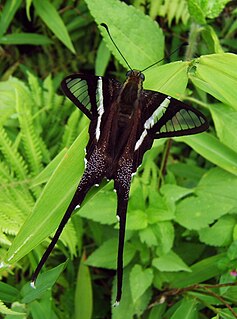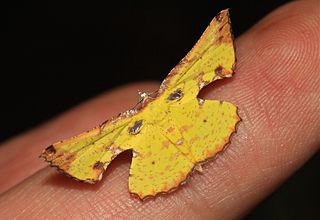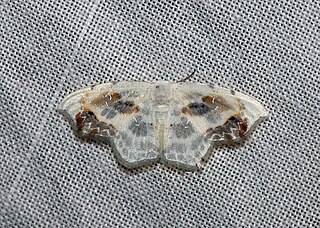
Lamproptera curius, the white dragontail, is a species of swallowtail butterfly native to parts of South Asia and Southeast Asia where it is common. It belongs to the dragontails genus, Lamproptera, of the swallowtail family, Papilionidae.
Diptilon is a genus of moths in the subfamily Arctiinae. The genus was erected by Otto von Prittwitz in 1870.

Corymica is a genus of moths in the family Geometridae described by Francis Walker in 1860.
Spectroreta is a monotypic moth genus belonging to subfamily Drepaninae erected by Warren in 1903. Its only species, Spectroreta hyalodisca, was described by George Hampson in 1896.
Diptilon aterea is a moth of the subfamily Arctiinae. It was described by William Schaus in 1901. It is found in Brazil and Paraguay.
Diptilon crassa is a moth of the subfamily Arctiinae. It was described by Hans Zerny in 1912. It is found in Colombia.
Diptilon flavipalpis is a moth of the subfamily Arctiinae. It was described by George Hampson in 1911. It is found in Argentina.
Diptilon gladia is a moth of the subfamily Arctiinae. It was described by E. Dukinfield Jones in 1914. It is found in Brazil.
Diptilon halterata is a moth of the subfamily Arctiinae. It was described by Johan Christian Fabricius in 1775. It is found in the Brazilian states of São Paulo, Rio de Janeiro and Paraná.
Diptilon hoffmannsi is a moth of the subfamily Arctiinae. It was described by Rothschild in 1911. It is found in Peru.
Diptilon sylpha is a moth of the subfamily Arctiinae. It was described by Paul Dognin in 1902. It is found in Ecuador.

Episcepsis venata is a moth of the family Erebidae. It was described by Arthur Gardiner Butler in 1877. It is found in Mexico and the Amazon region.
Hyalaethea solomonis is a moth of the subfamily Arctiinae. It was described by George Hampson. It is found on the Solomon Islands.
Lophocampa indistincta is a moth of the family Erebidae. It was described by William Barnes and James Halliday McDunnough in 1910. It is found in California, where it is only found on the Channel Islands.
Metamya bricenoi is a moth of the subfamily Arctiinae. It was described by Rothschild in 1911. It is found in Venezuela.
Leucoblepsis neoma is a moth in the family Drepanidae. It was described by Swinhoe in 1905. It is found in Singapore and on Peninsular Malaysia, Sumatra and Borneo.

Leucoblepsis renifera is a moth in the family Drepanidae. It was described by Warren in 1900. It is found on Peninsular Malaysia, Sumatra and Borneo.
Gogana abnormalis is a moth in the family Drepanidae first described by Warren in 1897. It is found on Borneo, Sumatra and Peninsular Malaysia.
Eupterote nigriceps is a moth in the family Eupterotidae. It was described by George Hampson in 1893. It is found in Sri Lanka.
Phiala esomelana is a moth in the family Eupterotidae. It was described by George Thomas Bethune-Baker in 1927. It is found in Cameroon.



